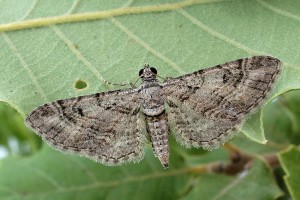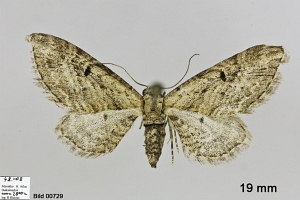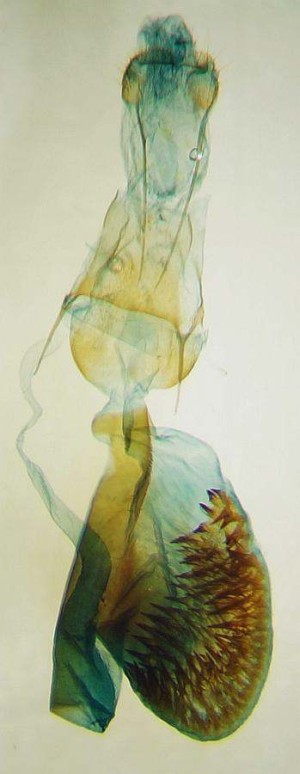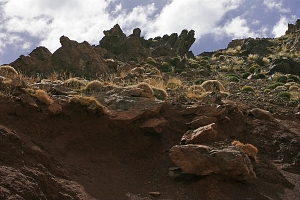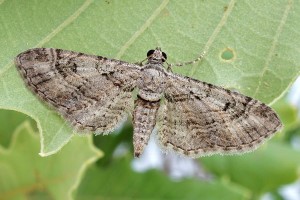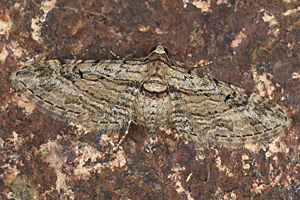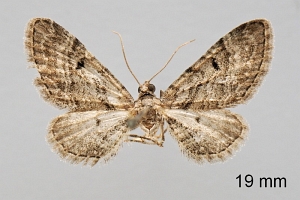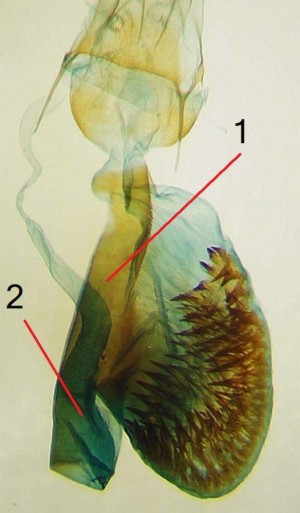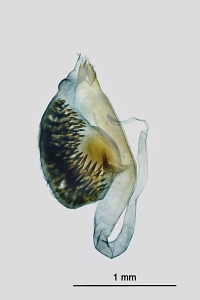2. Diagnose
2.1. Weibchen
2.2. Genitalien
2.2.1. Weibchen
Ein dornenloses, sklerotisiertes Band zieht vom Bursahals zum Ansatz des Ductus seminalis, doch bei E. weissi ist dieses am rechten Rand nicht mit Dornen besetzt (1). Ductus seminalis ist sichtbar größer und markanter als bei E. pauxillaria (2) (Text: Friedmar Graf).
2.3. Erstbeschreibung
„EUPITHECIA
[...]
weissi subsp. nov. (= euphrasiata Weiss) (17 k). Viel grauer, mit kaum einem braunen Ton, die dunklen Linien im ganzen stärker, u. T. rauher, unterbrochene subterminale Fleckung gewöhnlich entwickelt. Albarracin, August und Anfang September.“
3. Biologie
3.1. Habitat
3.2. Nahrung der Raupe
- [Apiaceae:] Bupleurum rigidum (Steifes Hasenohr)
- [Apiaceae:] Bupleurum fruticescens ssp. spinosum [= Bupleurum spinosum] (Dorniges Hasenohr)
Mironov & Tautel (2010) sollte es endlich gelingen, die Raupennahrung dieser Art zu klären - vorherige Vorschläge erwiesen sich dabei als falsch oder zumindest fraglich.
Mironov & Tautel (2010: 7) schrieben im Rückblick: "Just recently, the authors of the book Geometridae ibericae (work detailed to in the bibliography) give Artemisia herba-alba as being the probable foodplant for the larvae, but it appears that this assertion did not stem from observations in natura and was therefore merely supposition." Tatsächlich hatten die Autoren nicht nur den englischen, sondern auch den spanischen Text von Redondo et al. (2009: 254) gelesen, denn im englischen heißt es einfach "The caterpillar feeds on Artemisia herba-alba", im spanischen hingegen "La oruga es posible que viva sobre Artemisia herba-alba" - es ging also um eine Vermutung, sonst um nichts.
Die älteste Angabe ist die von Zerny (1935: 83), der zu seiner Meldung von "Eupithecia santolinata aus Marokko schrieb: "Es liegen mir leider nur weibliche Stücke vor, die sich von spanischen santolinata durch geringere Größe, [...] unterscheiden. Auch scheinen die Querlinien schräger zu liegen und die postmediane näher dem Zellschluß zu sein. Vielleicht liegt eine neue Art vor. Die Raupen leben höchstwahrscheinlich an der einer Santolina sehr ähnlichen Ormenis scariosa Ball." - Bei Mironov (2003: 308) wurde daraus: "Larva monophagous ? (1). Found on Ormenis scariosa (Asteraceae) (Morocco: Zerny 1935)." Aus einer Vermutung wurde also auch hier eine Fundmeldung. Mironov & Tautel (2010: 7) sind weiterhin überzeugt: "The oldest is the reference by ZERNY (1935). This gives the larva as feeding on Ormenis scariosa (Asteracae) in Morocco." Hier fehlt der Hinweis, dass auch diese Meldung nicht mehr als eine reine Vermutung war.
Mironov & Tautel (2010: 7-8) vermerkten dann: "One of us, MIRONOV, in the course of a visit to Budapest museum in 2007, was able to consult a paratype of Eupithecia africae Vojnits, taken in 1913 by H. Powell near Lambèse, Algeria (figs 5 & 6). After examining a slide of female genitalia from this specimen, prepared by Vojnits (N° 13 960), this proved to be Eupithecia weissi Prout, which enabled him to invalidate the taxon africae as a synonym. As fortune would have it, Harold Powell left us the following very precious remarks, on a handwritten label with very fine writing:"“Eclosion on 18-6-1913. Larva on Bupleurum spinosum 5-9-1912 on Dj.(ebel) Malou. 1900 m.”. Here then we have the first valid reference to the foodplant for this species. The first author passed on this information to the second with his new year greetings for 2008, asking him to take the matter further in France." Und tatsächlich gelang dort dann der Fund von 2 Raupen an Bupleurum rigidum. Die Suche war sehr mühsam - aber eben erfolgreich: "Since the Eupithecia females seemed little inclined to lay any eggs, it was deemed necessary to return to the locality in September in order to try and locate the larva. On September 5th. 2008, the second author arrived at the site where the E. weissi female was found. After several hours of searching, he found a small early instar larva about 1 cm long, saffron coloured, crawling rapidly across one of the wide green leaves at the foot of a Bupleurum rigidum plant (figs 11 to 13). In captivity in a bouquet of flower stems, it settled itself immediately in the flowering part of the plant, thus showing the perfect match between the colour of the first instar and that of the flower, a feature often seen with the Eupithecia, just like E. pimpinellata for example. Following a cloudy morning, it started to rain at the beginning of the afternoon thus putting an end to any prospecting. No other larva was located except for those of Phaiogramma etruscaria Zeller which were feeding on Bupleurum flowers (yet another new umbelifer to add to its extensive list of host plants). Among the many plants collected to act as a reserve stock for rearing (in Paris!) the small larva, another larva was found later, already at the second instar stage, a little less brightly coloured and holding itself outstretched like a broken twig."
Mit diesem Aussehen und der doch sehr spezialisierten Lebensweise ist zu erwarten, dass die Raupe sehr oligophag lebt. Dass sie daneben auch Asteraceen nutzt, ist nicht zu erwarten - hier sind falsche Spuren gelegt worden. Sie kamen einfach dadurch zustande, dass E. weissi vor ihrer Beschreibung zunächst als "var." zu E. santolinata gestellt worden war und jene Raupe an Asteraceae (konkret: Santolina chamaecyparissus) lebt.
(Autor: Erwin Rennwald)
4. Weitere Informationen
4.1. Synonyme
- Eupithecia barbaria Schwingenschuss, 1955
4.2. Faunistik
Das Taxon galt lange als Subspezies von E. euphrasiata und wurde von Mironow (2003) in den Artstatus erhoben. Da die Art nach ihm und der [Fauna Europaea] in Frankreich und Spanien vorkommt, ist sie in die Europaliste aufzunehmen.
4.3. Publikationsdatum der Erstbeschreibung
Nach einem Vermerk auf S. 193 wurde diese Lage am 13. März 1939 publiziert.
4.4. Literatur
- Mironov, V. (2003): Larentiinae II (Perizomini and Eupitheciini). — In: Hausmann, A. (ed.) (2003): The Geometrid Moths of Europe 4: 1-463.
- Mironov, V. & C. Tautel (2010): Eupithecia weissi Prout, 1938, et ses premiers états / and the early stages (Lep. Geometridae Larentiinae). — Oreina 8: 6-12. [PDF auf oreina.org]
- Erstbeschreibung: Seitz, A. [Hrsg.] (1934-1954): Die Gross-Schmetterlinge der Erde. Eine systematische Bearbeitung der bis jetzt bekannten Gross-Schmetterlinge. Supplement zu Band 4: Textband I-VIII, 1-766; Tafelband I-VIII, pl. I-LIII. Stuttgart (Alfred Kernen).




![Vorkommen in Frankreich (europäisches Territorium ohne Korsika) [Vandromme et al. (2020): Liste systématique et taxinomique des Lépidoptères de France]](/res/img/flag/fr.gif)
![Vorkommen in Spanien (Festland) [Vives Moreno A. (2014)]](/res/img/flag/es.gif)
![Vorkommen in Portugal (Festland) [Corley (2015): Lepidoptera of Continental Portugal]](/res/img/flag/pt.gif)

![Vorkommen in Algerien [Mironov (2003: 307)]](/res/img/flag/dz.gif)
